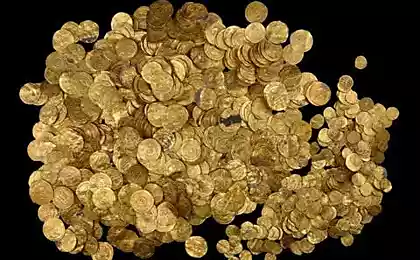1011
One day in search of treasure
Written several years is looking for different things, and ancient coins. Today, he will tell you about one of our trips for treasure in the village, which is located in the Stupino district of the Moscow region and is called Koledino.

Rise at 7:30. Quickly gather all the necessary, throw in a backpack device and shovel, decided to have breakfast on the spot.

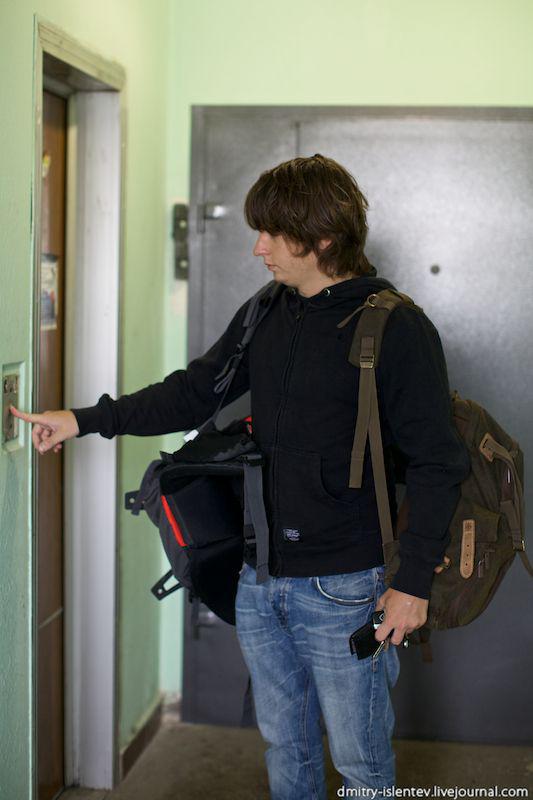
We headed for the village Koledino. In Moscow nice to see. The last time he stands 7m days a week, but today we were lucky.
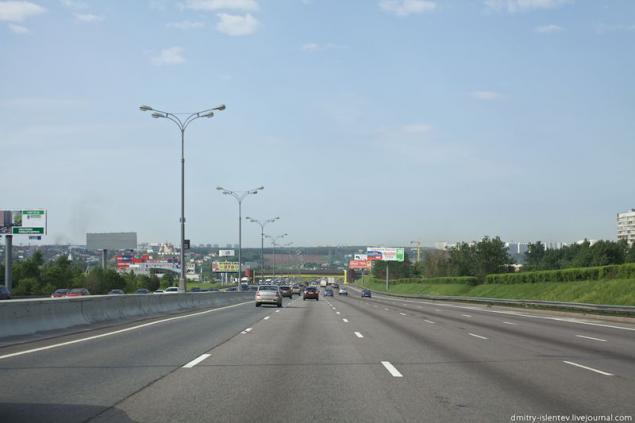
Kashirka made the toll section of the road. A good asphalt and limit of 110 km / h. I do not like it, but sometimes that's going to plug the toll.

Village Koledino more than 600 years. At the time, there was a private school, a library and a shop, but to the end of the Soviet power, they were closed. On the outskirts of the village is the small cemetery and the Chapel of St. John the Theologian built in the late 18th century from an old red brick, from which there were only walls. If you google, you can find the official site of the village, who is a local resident where more detail tells the story of the village. Having heard legends about their local village, we moved on to drip lordly field.

Previously, not far from the field that was the house of his master. Place in terms of search seemed very interesting, but the search is hampered by high grass. Dragged her through the coil was very difficult.

It soon went to the first "colored" signals. Many people think that metal detector (in common metaloiskatel) is able to be configured to search for gold, silver, etc., and can also search for these precious metals at a great depth. This is all, of course, is not true. Metal detector is only able to capture the presence of metal to a depth of 30cm (about the bayonet spade) and assess its conductivity. The same signal can be from the plug vodka and coins of the Russian Empire. Crosses and pre-Petrine money (flakes) are close to the signal wire aljuminevoj poseyanoy abundantly in the fields during the Soviet era. And the statistics do not always finds in favor of the "scales". 'Color signals "we call the signal that gives hope for a good find.

The field was not very trashy, so have a good signal the third brought the first coin. "Save" the coin is poor, we are called "kakalikami" barely noticeable visible monogram of Catherine II. Coin - in your pocket, go ahead.

After 10 minutes, allowing me to Mary, she had a great signal and she kindly invited me to dig.

It was found here such a bullet.

Then we dug a couple of jams, the third piece of wire, aluminum cans.

We decided to have a rest on the bridge near the pond next to which stood and manor house.
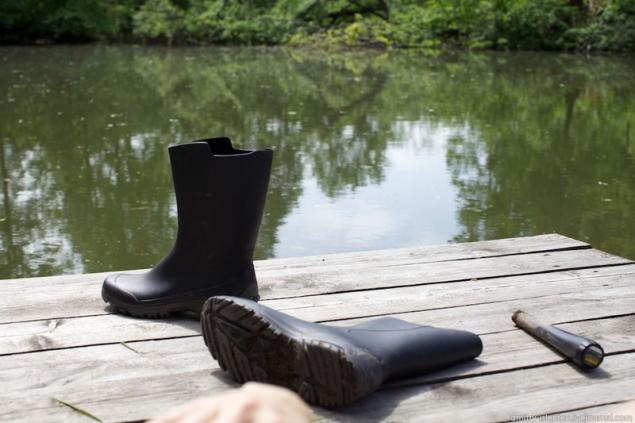
To the right of the boot pinpointer. This is a small metal detector, which facilitates the search for goals in an already excavated pit or placer land.
Washed in the pond only found a coin. Monogram Catherine became more clearly visible, but the year on the other side to discern, I never could.
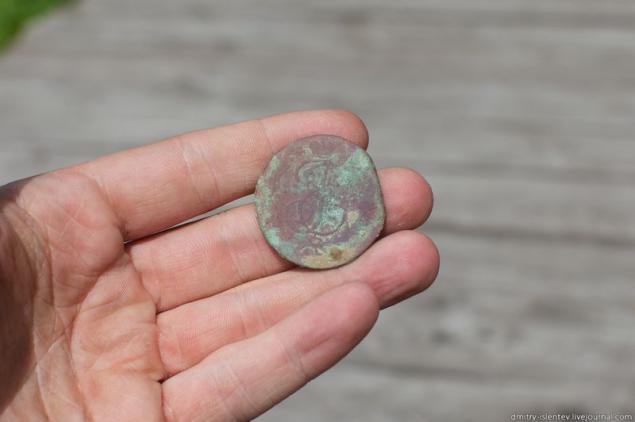
What we have beautiful places in the province.

Rested and decided to go deep into the village and try his luck there. On the way we met a large, slobbery dog.

Brick Church on the edge of the village, next to the cemetery to dig ... There will not be, we are adequate people)

Generally, there are third main types of instrument search: 1.Kopateli "the old days" the largest group of diggers, to which I myself belong. The main place to look for plowed fields, the village disappeared, gardens and so harmless for adult space archeology. 2. Search engines - those who are often shown on television, looking for the dead soldiers of the Second World, exploring archives and reduce the number of missing soldiers in general big fellows. Third kind of diggers - black diggers. They have problems with the site selection and moral principles. That's because these guys have an image problem because 99% of instrument negative finding in the news just about them. This is the least numerous species. Meanwhile, we went to yet another pond, all in their village 5t.

And that is a good signal and pleasant, though a common finding

Male crucifix XVIII - beginning of XX century. They are ubiquitous and extremely numerous. On the reverse side of the cross are usually reproduced the text of Psalm 67 "Let God." At the beginning of XX century. Master released their traders for the price of 3, 5 kopecks. apiece.

Paints deepened and we decided to go closer to home and to "break" the garden across the street from the house, it is not planted potatoes.

No grass, the center of the village, promising alignment)

And almost immediately find. 2 kopecks 1936. We are looking for more ...

Now a lot of the old days was the diggers and local residents had become accustomed to the people with the detector. And earlier, when digging near the village, certainly came envoys, who figured out that for the product is and what we're looking for. Now that interest in local employment does not cause, the maximum that they can be heard: "Che found?" Or "You ... it pits for a dropwise ..»
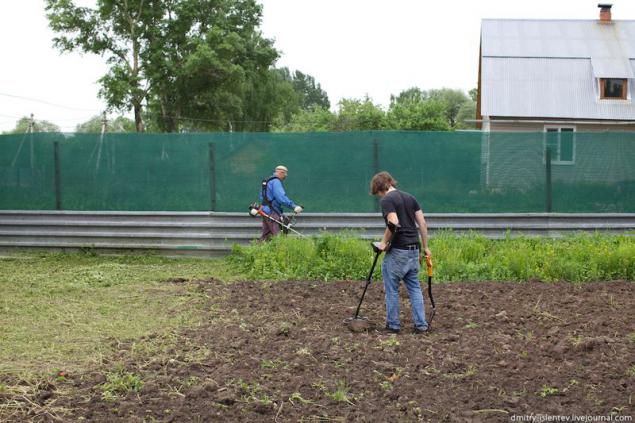
Horseshoe on a pony.
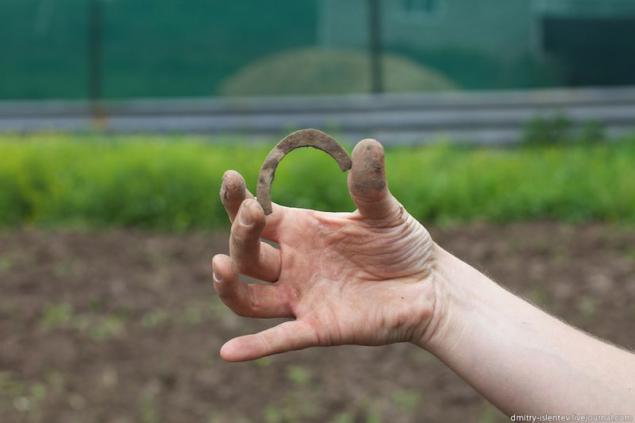
Spoon

"Koninck" cool. "Konin" We call on the part of harness, a common finding, but I love these kruglyazhki.

UAZ destroyed in the territory of the site promised a lot of garbage. But we had to check it.

The food is all the earth, and I decided to shift a little closer to the pond and immediately had a good signal. I dig ... 5 cents in 1924! Excellent!

As always, check the ground next to the excavated coins and coin signal!

2 penny 1924

3 steps to the left and another coin. 3 kopecks 1924! This special and you can imagine! It was decided to look for a number of 1 penny, but most of us are not lucky that day.

My discoveries in the pond


Sometimes more, though I remember trips where nothing is found. So we rejoice that there is. For me at all in this case for the third year, it has become a main process, not the result.

Around 9:00 we leave home
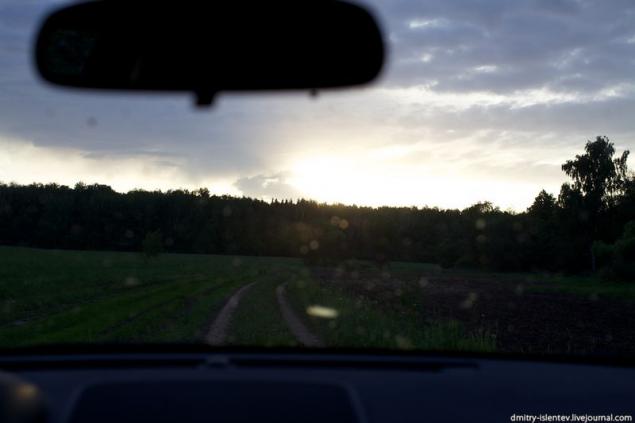
Now sleep.

Source: odin-moy-den.livejournal.com

Rise at 7:30. Quickly gather all the necessary, throw in a backpack device and shovel, decided to have breakfast on the spot.


We headed for the village Koledino. In Moscow nice to see. The last time he stands 7m days a week, but today we were lucky.

Kashirka made the toll section of the road. A good asphalt and limit of 110 km / h. I do not like it, but sometimes that's going to plug the toll.

Village Koledino more than 600 years. At the time, there was a private school, a library and a shop, but to the end of the Soviet power, they were closed. On the outskirts of the village is the small cemetery and the Chapel of St. John the Theologian built in the late 18th century from an old red brick, from which there were only walls. If you google, you can find the official site of the village, who is a local resident where more detail tells the story of the village. Having heard legends about their local village, we moved on to drip lordly field.

Previously, not far from the field that was the house of his master. Place in terms of search seemed very interesting, but the search is hampered by high grass. Dragged her through the coil was very difficult.

It soon went to the first "colored" signals. Many people think that metal detector (in common metaloiskatel) is able to be configured to search for gold, silver, etc., and can also search for these precious metals at a great depth. This is all, of course, is not true. Metal detector is only able to capture the presence of metal to a depth of 30cm (about the bayonet spade) and assess its conductivity. The same signal can be from the plug vodka and coins of the Russian Empire. Crosses and pre-Petrine money (flakes) are close to the signal wire aljuminevoj poseyanoy abundantly in the fields during the Soviet era. And the statistics do not always finds in favor of the "scales". 'Color signals "we call the signal that gives hope for a good find.

The field was not very trashy, so have a good signal the third brought the first coin. "Save" the coin is poor, we are called "kakalikami" barely noticeable visible monogram of Catherine II. Coin - in your pocket, go ahead.

After 10 minutes, allowing me to Mary, she had a great signal and she kindly invited me to dig.

It was found here such a bullet.

Then we dug a couple of jams, the third piece of wire, aluminum cans.

We decided to have a rest on the bridge near the pond next to which stood and manor house.

To the right of the boot pinpointer. This is a small metal detector, which facilitates the search for goals in an already excavated pit or placer land.
Washed in the pond only found a coin. Monogram Catherine became more clearly visible, but the year on the other side to discern, I never could.

What we have beautiful places in the province.

Rested and decided to go deep into the village and try his luck there. On the way we met a large, slobbery dog.

Brick Church on the edge of the village, next to the cemetery to dig ... There will not be, we are adequate people)

Generally, there are third main types of instrument search: 1.Kopateli "the old days" the largest group of diggers, to which I myself belong. The main place to look for plowed fields, the village disappeared, gardens and so harmless for adult space archeology. 2. Search engines - those who are often shown on television, looking for the dead soldiers of the Second World, exploring archives and reduce the number of missing soldiers in general big fellows. Third kind of diggers - black diggers. They have problems with the site selection and moral principles. That's because these guys have an image problem because 99% of instrument negative finding in the news just about them. This is the least numerous species. Meanwhile, we went to yet another pond, all in their village 5t.

And that is a good signal and pleasant, though a common finding

Male crucifix XVIII - beginning of XX century. They are ubiquitous and extremely numerous. On the reverse side of the cross are usually reproduced the text of Psalm 67 "Let God." At the beginning of XX century. Master released their traders for the price of 3, 5 kopecks. apiece.

Paints deepened and we decided to go closer to home and to "break" the garden across the street from the house, it is not planted potatoes.

No grass, the center of the village, promising alignment)

And almost immediately find. 2 kopecks 1936. We are looking for more ...

Now a lot of the old days was the diggers and local residents had become accustomed to the people with the detector. And earlier, when digging near the village, certainly came envoys, who figured out that for the product is and what we're looking for. Now that interest in local employment does not cause, the maximum that they can be heard: "Che found?" Or "You ... it pits for a dropwise ..»

Horseshoe on a pony.

Spoon

"Koninck" cool. "Konin" We call on the part of harness, a common finding, but I love these kruglyazhki.

UAZ destroyed in the territory of the site promised a lot of garbage. But we had to check it.

The food is all the earth, and I decided to shift a little closer to the pond and immediately had a good signal. I dig ... 5 cents in 1924! Excellent!

As always, check the ground next to the excavated coins and coin signal!

2 penny 1924

3 steps to the left and another coin. 3 kopecks 1924! This special and you can imagine! It was decided to look for a number of 1 penny, but most of us are not lucky that day.

My discoveries in the pond


Sometimes more, though I remember trips where nothing is found. So we rejoice that there is. For me at all in this case for the third year, it has become a main process, not the result.

Around 9:00 we leave home

Now sleep.

Source: odin-moy-den.livejournal.com



















